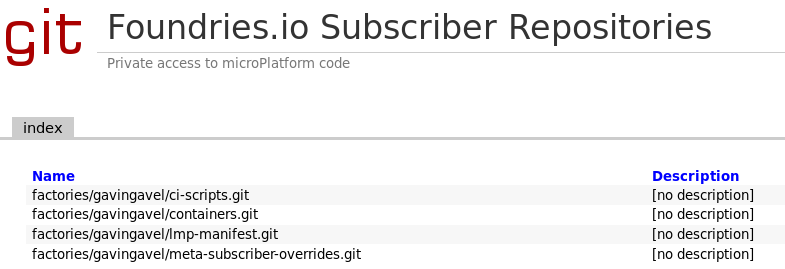Factory Source Code#
The FoundriesFactory™ Platform provides you with a private git sandbox, allowing you to maintain and customize your platform.
Navigate to https://source.foundries.io/factories/<factory>/:

Fig. 57 CGit browser#
You will find four git repositories:
meta-subscriber-overrides.git#This OE layer defines what is included in your Factory image. You can add board specific customizations and overrides, add and remove the packages provided in the default Linux microPlatform (LmP) base.
lmp-manifest.git#The repo manifest for the platform build. This defines which layer versions are included in your platform image. The
default.xmlfile is the latest released manifest of the LmP.<factory>.xmlincludes your Factory changes, allowing you to customize your image against our common base.containers.git#This is where containers and Docker-compose apps are defined. It allows you to define what containers to build, and how to orchestrate them on the platform.
ci-scripts.git#Defines your platform and container build job to our continuous integration system which uses the data from
masterbranch. Note that you are prevented from making a commit changing thelmp:machines:stanza , as well as any changes altering the history (force push is disabled). Factories are created to support specific machines. If you need to alter this behavior after starting a Factory, please open a support ticket.
Triggering Builds#
If you push changes to either lmp-manifest.git or meta-subscriber-overrides.git, a new platform build will be triggered.
If successful, the update will deploy to your registered devices.
Changes pushed to containers.git will trigger a container build job.
Defined containers will be pushed to your Factory’s private Docker registry at:
https://hub.foundries.io/<factory>/<container>:latest
Note
Commit messages that include [skip ci] or [ci skip] will not trigger CI builds.
Configuring the CI to Build New Branches#
By default, meta-subscriber-overrides, lmp-manifest and containers have the single branch, main.
For these repos, it is recommended to also have a devel branch for non-production purposes.
ci-scripts has the single default branch master.
Platform Branches#
To create new buildable platform branches, first enable the new branch in ci-scripts.
For example, if you wanted to add a development branch named feature1:
lmp:
tagging:
refs/heads/main:
- tag: main
refs/heads/feature1:
- tag: feature1
Then branch out from the wanted branches in meta-subscriber-overrides and lmp-manifest.
For example, using main as a base for the new branch:
$ cd meta-subscriber-overrides
$ git checkout main
$ git checkout -b feature1
$ git commit -m "[skip ci] create devel branch" --allow-empty
$ git push --set-upstream origin feature1
The lmp-manifest repo change is similar as above, but includes an additional change to point to the correct meta-subscriber-overrides branch:
$ cd lmp-manifest
$ git checkout main
$ git checkout -b feature1
$ sed -i 's/main/feature1/' <factory_name>.xml
$ git add <factory_name>.xml
$ git commit -m "point meta-subscriber-overrides to correct branch"
$ git push --set-upstream origin feature1
After the last step, a platform build for the feature1 branch is triggered for your Factory.
Container Branches#
To create new buildable container branches, first enable the new branch in ci-scripts, for example:
containers:
tagging:
refs/heads/main:
- tag: main
refs/heads/feature1:
- tag: feature1
Then branch out from the wanted branch in containers, for example using main:
$ cd containers
$ git checkout main
$ git checkout -b feature1
$ git push --set-upstream origin feature1
After the last step, a container build for the feature1 is triggered for your Factory.

